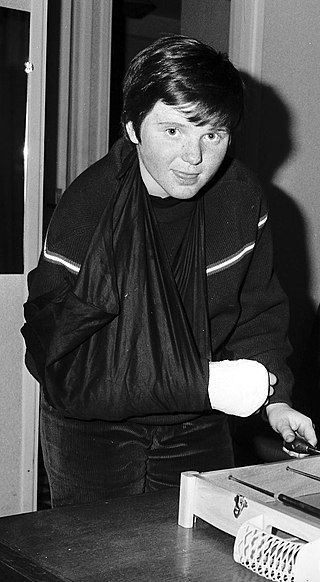
Downhill is a form of alpine skiing competition. Whereas the other alpine skiing events emphasize turning and technique, downhill emphasizes "the six components of technique, courage, speed, risk, physical condition and judgement", according to the FIS "International Ski Competition Rules (ICR)". Speeds of up to 130 km/h (81 mph) are common in international competition. Athletes must have an aerodynamically efficient tuck position to minimize drag and increase speed.

Giant slalom (GS) is an alpine skiing and alpine snowboarding competitive discipline. It involves racing between sets of poles ("gates") spaced at a greater distance from each other than in slalom but less than in Super-G.

Super giant slalom, or super-G, is a racing discipline of alpine skiing. Along with the faster downhill, it is regarded as a "speed" event, in contrast to the technical events giant slalom and slalom. It debuted as an official World Cup event during the 1983 season and was added to the official schedule of the World Championships in 1987 and the Winter Olympics in 1988.

Lindsey Caroline Vonn is an American former World Cup alpine ski racer on the US Ski Team. She won four World Cup overall championships – third amongst female skiers to Annemarie Moser-Pröll and Mikaela Shiffrin – with three consecutive titles in 2008, 2009, and 2010, plus another in 2012. Vonn won the gold medal in downhill at the 2010 Winter Olympics, the first one for an American woman. She also won a record eight World Cup season titles in the downhill discipline, five titles in super-G, and three consecutive titles in the combined (2010–2012). In 2016, she won her 20th World Cup crystal globe title, the overall record for men or women, surpassing Ingemar Stenmark of Sweden, who won 19 globes from 1975 to 1984. She has the third highest super ranking of all skiers, men or women.

Alpine skiing has been contested at every Winter Olympics since 1936, when a combined event was held in Garmisch-Partenkirchen, Germany.
Combined is an event in alpine ski racing. The event format has changed within the last 30 years. A traditional combined competition is a two-day event consisting of one run of downhill and two runs of slalom; each discipline takes place on a separate day. The winner is the skier with the fastest aggregate time. Until the 1990s, a complicated point system was used to determine placings in the combined event. Since then, a modified version, called either a "super combined" or an "Alpine combined", has been run as an aggregate time event consisting of two runs: first, a one-run speed event and then only one run of slalom, with both portions held on the same day.
The 39th World Cup season began in October 2004 in Sölden, Austria, and concluded in March 2005 at the World Cup finals in Lenzerheide, Switzerland. The overall winners were Bode Miller of the U.S. and Anja Pärson of Sweden.
The 38th World Cup season began in October 2003 in Sölden, Austria, and concluded at the World Cup finals in Sestriere, Italy, in March 2004. Sestriere would host the alpine skiing events at the 2006 Winter Olympics.
The third World Cup season began in December 1968 and concluded in March 1969. This was the first season in which the races began prior to January 1, and that change immediately became permanent. Karl Schranz of Austria won the first of two consecutive overall titles. Gertrude Gabl of Austria won the women's overall title. For the first and only time in World Cup history, a discipline trophy was shared by more than two people, as four men tied for the men's slalom trophy.
The 2nd World Cup season began in January in West Germany and concluded in April in the US Jean-Claude Killy of France repeated as the overall champion, and announced his retirement from World Cup competition. Nancy Greene of Canada repeated as the women's World Cup overall champion, and announced her retirement from World Cup competition.
The 1st World Cup races began in early January in West Germany and concluded in late March in the United States. Jean-Claude Killy of France dominated the men's competition, winning each of the three disciplines and the overall title. Nancy Greene of Canada edged out Marielle Goitschel of France for the women's overall title, her first of two consecutive titles, defending successfully in 1968.

Bernhard Russi is a former World Cup alpine ski racer from Switzerland. Born in Andermatt in the canton of Uri, he is an Olympic, World Cup, and World champion in the downhill event.

Marielle Goitschel is a French former alpine skier. Marielle is the younger sister of Christine Goitschel, another champion skier of the time, and the aunt of speed skier Philippe Goitschel.
Women's downhill World Cup 1967/1968

Isabelle Mir is a French former Alpine skier. At the 1968 Olympics in Grenoble Mir was silver medalist in the downhill. She received a silver medal at the FIS Alpine World Ski Championships 1970.

Birds of Prey is a World Cup downhill ski course in the western United States, located at Beaver Creek Resort in Avon, Colorado. The race course made its World Cup debut 26 years ago in December 1997.
For the 1992 Winter Olympics in Albertville, France, a total of thirteen sports venues were used. Val-d'Isère has been part of the Alpine Skiing World Cup since the late 1960s while Tignes served as host of the first Freestyle World Ski Championships in 1986. Most of the venues used were constructed between 1987 and mid 1990 with the test events taking place in late 1990 and early 1991. It was the last Winter Olympics with an outdoor speed skating rink which led to weather issues for three of the ten events. Three cross-country skiing events were run in snowstorms while the men's 20 km biathlon was found to be 0.563 km (0.350 mi) too short. The downhill events in alpine skiing were criticized for being too steep. Freestyle skiing made its official debut at these games with the men's winner being stormed after his win while the women's winner won her event in a snow storm. La Plagne hosted the skeleton World Championships in 1993 while Val-d'Isère hosted the Alpine World Ski Championships in 2009.
Gerhard Nenning was an Austrian former alpine skier who competed in the 1964 Winter Olympics and 1968 Winter Olympics.
The Women's Downhill competition of the Grenoble 1968 Olympics was held at Chamrousse on Saturday, 10 February.

The women's downhill in the 2022 FIS Alpine Skiing World Cup consisted of nine events including the finals. Defending champion Sofia Goggia of Italy, who won four of the five downhills in which she competed in 2020-21, continued her domination in 2021-22 by again winning four of the first five downhills. Goggia took a commanding lead in the discipline after American Breezy Johnson, who finished second in each of the first three downhills, missed the rest of the season with a knee injury. Goggia then suffered her own knee injury, including a broken bone and ligament tears, while training for the last downhill prior to the 2022 Winter Olympics, but she was able to continue competing within a month and, after all but the final race of the season, had such a commanding lead that only one other competitor even had a theoretical possibility of overtaking her. At the finals, Suter failed to score, and Goggia won her second consecutive discipline championship.








